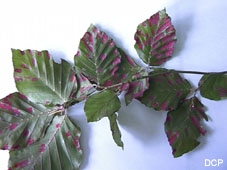Insects and mites
The entomology/acarology laboratory detects and identifies harmful and beneficial insects and mites. Samples can originate from agricultural and horticultural crops, public green, private gardens, stored products or houses and other buildings.
The DCP entomology laboratory is a National Reference Laboratory and has obtained an ISO17025 accreditation for the detection and identification of the melon thrips, Thrips palmi, and the Western Corn Rootworm, Diabrotica virgifera. This lab is also certified by the Belgian NPPO (Federal Agency for the Safety of the Food Chain) to perform a wide range of non-accredited detection and identification procedures for invasive (quarantine) arthropods including Drosophila suzukii, Anoplophora spp., Monochamus spp., Epitrix spp. and others. These analyses are primarily done in the context of phytosanitary import and export controls of plant material and of monitoring campaigns.
Methods for detection
 |  |
| Berlese funnels | Fruit stored for breeding of fruit flies |
Using a stereomicroscope (direct isolation), insects and mites are isolated from a plant sample on the day it is received. As necessary, plant material is further investigated using either a Berlese funnel (isolation under the influence of light and heat), washing (e.g. to detect tarsonemid mites), or with the centrifugation-flotation technique (e.g. to detect rust and gall mites). Detection of insects and mites in stored products is performed using a stereomicroscope. After isolation, the organisms are preserved in an alcohol solution for further identification.
Identification
Insects and mites are generally identified by their typical morphological features. This is done using determination keys and a stereomicroscope or microscope. When identifying smaller insects or mites, a microscopic slide of the organism is first prepared.
In certain cases, morphology alone is not sufficient for reliable identification. Insect stages (eggs, larvae and pupae) of various organisms often resemble each other, and insect remains (piece of antennae, legs or larval skins) are not complete enough for morphological identification. In these cases, molecular techniques are used to either identify the organism or confirm the morphological identification in case of doubt. We apply validated molecular (EPPO) protocols (e.g. PCR, q-PCR, RFLP) to confirm specific suspected organisms such as Thrips palmi, Lyriomyza spp., etc. In other cases, we use DNA sequencing. By generating the organism’s DNA barcode (a relatively short DNA sequence specific to the organism) and aligning this sequence with existing databases, we can distinguish it from other related organisms.
The laboratory also has an extensive collection of insects and mites as reference material.
 |  |  |  |
| Pheromone trap for Ceratitis capitata | Damage from the horse chestnut leafminer Cameraria ohridella | Larva of the banana moth Opogona sacchari in Kentia seed | A wasp’s nest |
 |  |
| Damage by Schizotetranychus celarius on bamboo | The gall mite Aceria faginea on beech |
 Diagnostic Centre for Plants
Diagnostic Centre for Plants
